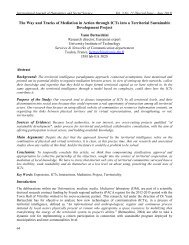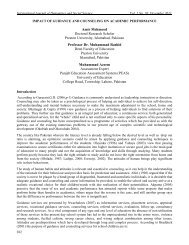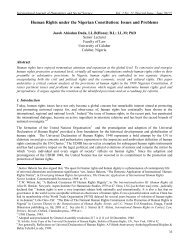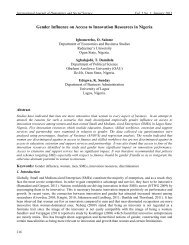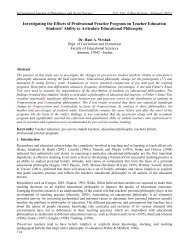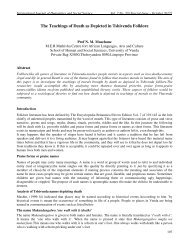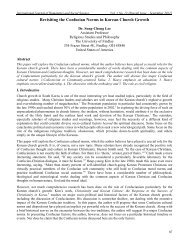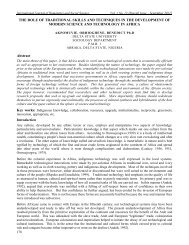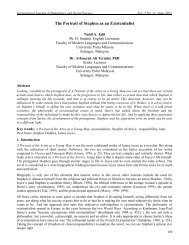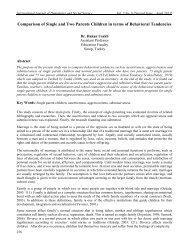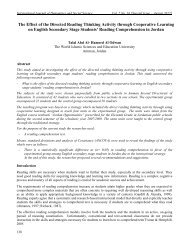At the present time progress in any field is impossible without research
At the present time progress in any field is impossible without research
At the present time progress in any field is impossible without research
Create successful ePaper yourself
Turn your PDF publications into a flip-book with our unique Google optimized e-Paper software.
International Journal of Humanities and Social Science Vol. 1 No. 16; November 2011<br />
1. Introduction<br />
296<br />
Parents’ Gender Biased <strong>At</strong>titude towards Education<br />
Dr. Ashiq Hussa<strong>in</strong> Dogar<br />
Controller Exam<strong>in</strong>ations<br />
University of Education<br />
College Road, Township, Road<br />
Lahore, Pak<strong>is</strong>tan<br />
Muhammad Azeem<br />
Assessment Expert<br />
Punjab Education Assessment System (PEAS)<br />
University of Education<br />
College Road, Township<br />
Lahore, Pak<strong>is</strong>tan<br />
Shazia Feroze<br />
Prov<strong>in</strong>cial Institute of Teacher Education<br />
University of education<br />
Lahore.<br />
Azra Shakoor<br />
Doctoral Research Scholar<br />
University of Education<br />
College Road, Township<br />
Lahore, Pak<strong>is</strong>tan<br />
There <strong>is</strong> a strong demand and genu<strong>in</strong>e desire of an educational program that all <strong>the</strong> study should make adjustment<br />
to modern concept and application to common need of life. Progress <strong>in</strong> <strong>any</strong> <strong>field</strong> requires a clear understand<strong>in</strong>g of<br />
its elementary concept. Pak<strong>is</strong>tan <strong>is</strong> a develop<strong>in</strong>g country and <strong>is</strong> fac<strong>in</strong>g m<strong>any</strong> problems <strong>in</strong> education system<br />
<strong>in</strong>clud<strong>in</strong>g of higher rate of illiteracy of its population especially <strong>the</strong> female population. Accord<strong>in</strong>g to plann<strong>in</strong>g<br />
comm<strong>is</strong>sion of Pak<strong>is</strong>tan’s report 2010, <strong>in</strong> 2008-2009 it <strong>is</strong> estimated approximately above 43% of total and 55% of<br />
female. Th<strong>is</strong> problem <strong>is</strong> root<strong>in</strong>g various o<strong>the</strong>r problems also. Majority of Pak<strong>is</strong>tani people are shackled with ageold<br />
and functionally useless customs and traditions, which, may result <strong>in</strong> wastage of humanity effort and material<br />
resources. Gender biasless education <strong>is</strong> receiv<strong>in</strong>g much emphas<strong>is</strong> at <strong>present</strong>. Our 51% population <strong>is</strong> female. It <strong>is</strong><br />
really needed to educate both male and female, who can face all challenges of <strong>present</strong> technological era. Lack of<br />
education especially female education <strong>is</strong> most significant factor contribut<strong>in</strong>g to underdevelopment of Pak<strong>is</strong>tan.<br />
The educational backwardness of Pak<strong>is</strong>tani people <strong>is</strong> most eye-catch<strong>in</strong>g <strong>in</strong> respect of women’s education although<br />
accord<strong>in</strong>g to Islamic po<strong>in</strong>t of view it <strong>is</strong> obligatory duty of each Muslim man and woman to seek knowledge. It <strong>is</strong><br />
generally recognized to teach a boy <strong>is</strong> to teach one person but to teach a girl <strong>is</strong> to teach a family. But <strong>in</strong> Pak<strong>is</strong>tan,<br />
<strong>in</strong> <strong>the</strong> past, female education has been particularly neglected <strong>in</strong> <strong>the</strong> nation’s educational program. Parents are <strong>the</strong><br />
pioneers <strong>in</strong> <strong>the</strong> <strong>field</strong> of general and specific <strong>in</strong>structions for <strong>the</strong>ir children. Family traditions, customs and beliefs<br />
have been an everlast<strong>in</strong>g impression upon <strong>the</strong> mental d<strong>is</strong>position of <strong>the</strong> children’s behavior and attitude. Parent’s<br />
attitude <strong>is</strong> important for send<strong>in</strong>g <strong>the</strong>ir children to school, because a child <strong>is</strong> liv<strong>in</strong>g with <strong>the</strong>m and he or she has to<br />
obey parents orders especially <strong>in</strong> Pak<strong>is</strong>tani society, fur<strong>the</strong>r <strong>the</strong>y are dependent on <strong>the</strong>ir parents. Therefore, <strong>the</strong>re <strong>is</strong><br />
a dire need to study <strong>the</strong> attitude of parents to understand <strong>the</strong> problem of <strong>the</strong> low participation rate if female <strong>in</strong><br />
Pak<strong>is</strong>tan. Th<strong>is</strong> study has been designed keep<strong>in</strong>g <strong>in</strong> view <strong>the</strong> above-mentioned need.<br />
2. Objectives of <strong>the</strong> study<br />
Follow<strong>in</strong>g are <strong>the</strong> objectives of <strong>the</strong> study:<br />
1. To survey <strong>the</strong> attitude of parents towards <strong>the</strong> education of <strong>the</strong>ir girl child.<br />
2. To ascerta<strong>in</strong> <strong>the</strong> prejudice and bias of parents aga<strong>in</strong>st female education.<br />
3. To f<strong>in</strong>d out <strong>the</strong> importance of <strong>the</strong> parents attachment to <strong>the</strong> teach<strong>in</strong>g and learn<strong>in</strong>g of <strong>the</strong>ir girls.
© Centre for Promot<strong>in</strong>g Ideas, USA www.ijhssnet.com<br />
4. To f<strong>in</strong>d out <strong>the</strong> relationship between education and <strong>the</strong> attitude of parents.<br />
5. To f<strong>in</strong>d out <strong>the</strong> relationship between <strong>in</strong>come and attitude of <strong>the</strong> parents.<br />
6. To f<strong>in</strong>d out <strong>the</strong> difference <strong>in</strong> attitude of fa<strong>the</strong>rs and mo<strong>the</strong>rs towards education of <strong>the</strong>ir girl child.<br />
3. Significance of <strong>the</strong> study<br />
Its f<strong>in</strong>d<strong>in</strong>gs might be helpful for <strong>the</strong> parents, teachers, social workers, planners, NGOs, funders, and organizers of<br />
women education program development <strong>in</strong> <strong>the</strong> country.<br />
4. Delimitation<br />
The study <strong>is</strong> delimited to:<br />
1. Only <strong>the</strong> parents of <strong>the</strong> girls, already study<strong>in</strong>g <strong>in</strong> elementary class will be <strong>in</strong>cluded. Researchers assumed<br />
that such parents would be <strong>in</strong> a better position to forma op<strong>in</strong>ion about female education.<br />
2. The f<strong>in</strong>d<strong>in</strong>gs of th<strong>is</strong> study are based on <strong>the</strong> stated op<strong>in</strong>ions of <strong>the</strong> sampled parents.<br />
3. The socio-economics status of <strong>the</strong> parents <strong>is</strong> determ<strong>in</strong>ed by two <strong>in</strong>dicators, education and <strong>in</strong>come of<br />
parents provided <strong>in</strong> attitude scale.<br />
4. S<strong>in</strong>ce it <strong>is</strong> not possible ei<strong>the</strong>r to <strong>in</strong>terview all parents personally, so a common attitude scale was<br />
developed and sends to elicit op<strong>in</strong>ion of <strong>the</strong> parents.<br />
5. Assumptions<br />
Almost all <strong>the</strong> parents resid<strong>in</strong>g <strong>in</strong> <strong>the</strong>ir selected area are educated enough to cooperate with <strong>the</strong> <strong>in</strong>vestigators.<br />
1. Parents are actively <strong>in</strong>terested <strong>in</strong> <strong>the</strong> education of <strong>the</strong>ir child.<br />
2. Parents are aware of problems of <strong>the</strong>ir girl child and problems of school.<br />
6. Hypo<strong>the</strong>ses of <strong>the</strong> study<br />
Follow<strong>in</strong>g <strong>the</strong> hypo<strong>the</strong>ses of <strong>the</strong> study:<br />
1. Fa<strong>the</strong>rs and mo<strong>the</strong>rs do not differ <strong>in</strong> attitude towards education of <strong>the</strong>ir girl child.<br />
2. Higher <strong>the</strong> education level of parents more favorable attitude towards <strong>the</strong> education of <strong>the</strong>ir girl child.<br />
3. Higher <strong>the</strong> <strong>in</strong>come level of parents more favorable attitude towards <strong>the</strong> education of <strong>the</strong>ir girl child.<br />
4. Higher <strong>the</strong> socio-economic level of <strong>the</strong> parent, more favorable attitude towards <strong>the</strong> education of <strong>the</strong>ir girl<br />
child.<br />
7. Review of Related Literature<br />
<strong>At</strong>titude has been <strong>the</strong> most fasc<strong>in</strong>at<strong>in</strong>g subject of study <strong>in</strong> social psychology, and it still cont<strong>in</strong>ues to be as such.<br />
Allport (1947) def<strong>in</strong>e attitude as;<br />
“An attitude <strong>is</strong> a mental and neural state of read<strong>in</strong>ess, organized through experience, exert<strong>in</strong>g a directive or<br />
dynamic <strong>in</strong>fluence upon <strong>the</strong> <strong>in</strong>dividual's response to all objects and situations with which it <strong>is</strong> related”.<br />
Important elements of Allport's def<strong>in</strong>ition are:<br />
<strong>At</strong>titudes are private<br />
<strong>At</strong>titudes are formed and organized through experience. That <strong>is</strong>, we are not born with our<br />
<br />
attitudes we acquire <strong>the</strong>m via <strong>the</strong> SOCIALIZATION process<br />
An attitude <strong>is</strong> not passive, but ra<strong>the</strong>r it exerts a dynamic or directive <strong>in</strong>fluence on behavior.<br />
<strong>At</strong>titudes believed to directly <strong>in</strong>fluence behavior<br />
Murphy, Murphy and Newcomb (1937) def<strong>in</strong>e attitude as;<br />
“<strong>At</strong>titude <strong>is</strong> a primarily a way of be<strong>in</strong>g “set towards or aga<strong>in</strong>st certa<strong>in</strong> th<strong>in</strong>gs”<br />
An o<strong>the</strong>r view states that an attitude <strong>is</strong> a;<br />
“Tendency or d<strong>is</strong>position to evaluate an object or <strong>the</strong> symbol of that <strong>in</strong>ject <strong>in</strong> a certa<strong>in</strong> way”<br />
Above def<strong>in</strong>ition focus on <strong>the</strong> effective tendency to favorable or unfavorable object and entirely d<strong>is</strong>card <strong>the</strong> notion<br />
that <strong>any</strong> overt behavior <strong>in</strong> implied.<br />
From different def<strong>in</strong>itions we identify <strong>the</strong> follow<strong>in</strong>g character<strong>is</strong>tics of attitude;<br />
1. <strong>At</strong>titudes are not <strong>in</strong>born: <strong>the</strong>y are learned through experience.<br />
2. They can be <strong>in</strong>ferred from <strong>the</strong> observed antecedent stimulus and consequent pattern. <strong>At</strong>titudes have<br />
objective reference: one holds an attitude regard<strong>in</strong>g some object; person or <strong>is</strong>sue.<br />
They differ from motives and personality trait that have subjective referenced.<br />
3. <strong>At</strong>titudes are positive or negative, pro or anti.<br />
297
International Journal of Humanities and Social Science Vol. 1 No. 16; November 2011<br />
4. Once formed, <strong>the</strong>y are unlikely to change under ord<strong>in</strong>ary conditions.<br />
5. From operational po<strong>in</strong>t of view attitudes are manifested <strong>in</strong> <strong>the</strong> cons<strong>is</strong>tency of references made to a<br />
specific objector situation.<br />
<strong>At</strong>titudes have three components<br />
a) Beliefs, or propositions about <strong>the</strong> way, th<strong>in</strong>gs are or ought to be.<br />
b) Affects, or emotions associated with <strong>the</strong>se beliefs, measurable <strong>in</strong> terms of physiological reactions or<br />
<strong>in</strong>tensity and style of response;<br />
c) Action <strong>in</strong>tention components, with a given probability of respond<strong>in</strong>g <strong>in</strong> specific way.<br />
7.1 Nature of attitudes<br />
Thurstone and Clave (1929) def<strong>in</strong>e attitude as:<br />
“The sum total of man <strong>in</strong>cl<strong>in</strong>ations and feel<strong>in</strong>g, prejudice and bias, preconceived, notions, ideas, fears, threats and<br />
convictions about <strong>any</strong> specific topic” An attitude <strong>is</strong> a state of read<strong>in</strong>ess that exerts a directive and come <strong>time</strong> a<br />
compulsive <strong>in</strong>fluence upon an <strong>in</strong>dividual behavior. <strong>At</strong>titude may be ei<strong>the</strong>r general or specific, for example a<br />
person has general attribute of liberal<strong>is</strong>m may behave as a high conservative manner <strong>in</strong> a particular situation <strong>in</strong><br />
which h<strong>is</strong> personal welfare may be threatened. An attitude towards a certa<strong>in</strong> person <strong>is</strong> specific. Th<strong>is</strong> brief<br />
<strong>in</strong>duction of <strong>the</strong> nature of <strong>the</strong> attitude will furn<strong>is</strong>h <strong>the</strong> students sufficient background concern<strong>in</strong>g <strong>the</strong> psychological<br />
character<strong>is</strong>tics of attitude for <strong>the</strong> measur<strong>in</strong>g <strong>in</strong>struments.<br />
7.2 Women’s education and its importance<br />
The comm<strong>is</strong>sion on <strong>the</strong> national education stressed <strong>the</strong> role, which <strong>the</strong> Pak<strong>is</strong>tani women are to play <strong>in</strong> <strong>the</strong><br />
development of <strong>the</strong> country and an importance of women’s education it said:<br />
Unless a mo<strong>the</strong>r <strong>is</strong> educated <strong>the</strong>re will never be an educated home or an educated community. <strong>At</strong> <strong>the</strong> same <strong>time</strong><br />
primary education <strong>is</strong> <strong>the</strong> first essential step <strong>in</strong> <strong>the</strong> education program through which we must secure large numbers<br />
of women for teach<strong>in</strong>g; medic<strong>in</strong>e, nurs<strong>in</strong>g, and a wide variety of careers and professions. It <strong>is</strong> essential that <strong>the</strong><br />
foundation of education for women are firmly consolidated and that <strong>the</strong> facilities provided for girls education be<br />
<strong>in</strong> very respect equal to those available for boys. We recommended <strong>the</strong>refore that <strong>in</strong> <strong>the</strong> future expansion of<br />
primary education <strong>the</strong> facilities provided for girls should be equal both <strong>in</strong> quantity and quality of education to<br />
those provided for boys.<br />
In d<strong>is</strong>cuss<strong>in</strong>g <strong>the</strong> role of Pak<strong>is</strong>tan women it said;<br />
There can be no doubt that <strong>the</strong> women of Pak<strong>is</strong>tan are serv<strong>in</strong>g to play <strong>the</strong>ir part <strong>in</strong> ra<strong>is</strong><strong>in</strong>g <strong>the</strong> status of <strong>the</strong>mselves,<br />
<strong>the</strong>ir families and <strong>the</strong>ir nation. Ours women have already won for <strong>the</strong>m an available reputation at <strong>the</strong> highest level<br />
of our national life as well as I <strong>in</strong>ter national circles. We are confident from <strong>the</strong> spirit which <strong>the</strong> women of<br />
Pak<strong>is</strong>tan have shown <strong>in</strong> such achievements as those of <strong>the</strong> “All Pak<strong>is</strong>tan Women’s Association” that <strong>the</strong>y can<br />
assumed a role of great importance <strong>in</strong> <strong>the</strong> consolidation and development of country if <strong>the</strong>ir dynam<strong>is</strong>m and<br />
dedication can be nurtured and <strong>the</strong>ir efforts guided <strong>in</strong> to <strong>the</strong>se channels where <strong>the</strong>y can be of <strong>the</strong> greatest service”<br />
7.3 <strong>At</strong>titude scales<br />
<strong>At</strong>titudes and beliefs are typically measured by <strong>the</strong> use of scales. A scale <strong>is</strong> a cont<strong>in</strong>uum marked off <strong>in</strong> to<br />
numerical units that can be applied to some object of state <strong>in</strong> order to measure a particular property of it. The scale<br />
rests on <strong>the</strong> assumption that <strong>the</strong>re are underly<strong>in</strong>g dimensions along which attitude can be ranged. Scal<strong>in</strong>g <strong>is</strong> a<br />
method by which each respondent’s attitude can be assigned numerical value to <strong>in</strong>dicate h<strong>is</strong> or her position on <strong>the</strong><br />
dimension of <strong>in</strong>terest. Techniques of attitude scale construction are concerned particularly with identify<strong>in</strong>g <strong>the</strong><br />
underly<strong>in</strong>g dimension as homogeneous and l<strong>in</strong>ear (so that only one attribute <strong>is</strong> be<strong>in</strong>g measured on a straight l<strong>in</strong>e)<br />
and with dev<strong>is</strong><strong>in</strong>g reproducible, reliable and valid <strong>research</strong> <strong>in</strong>strument. In m<strong>any</strong> scale an attempt <strong>is</strong> made to have<br />
equal <strong>in</strong>tervals on <strong>the</strong> scale that <strong>in</strong>terval-level measurement <strong>is</strong> possible.<br />
7.4 Likert scale<br />
In <strong>the</strong> measurement of attitudes <strong>the</strong> most frequently used scale <strong>is</strong> <strong>the</strong> Likert scale. It looks like th<strong>is</strong>;<br />
SA A U D SD<br />
Strongly Agree Agree Undecided D<strong>is</strong>agree Strongly D<strong>is</strong>agree<br />
298
© Centre for Promot<strong>in</strong>g Ideas, USA www.ijhssnet.com<br />
Each respondent attaches h<strong>is</strong>/her own value to <strong>the</strong> po<strong>in</strong>t on <strong>the</strong> scale. The respondent <strong>is</strong> <strong>in</strong>structed to circle <strong>the</strong><br />
letter that best reflects h<strong>is</strong> or her op<strong>in</strong>ions.<br />
Scroll<strong>in</strong>g a Likert scale requires <strong>the</strong> follow<strong>in</strong>gs;<br />
On a positive item scare SA=5, A=4, U=3, D=2, SD=1; on a negative item score SA=1, A=2 U=3, D=4, SD=5.<br />
Add all item scores to get a sum that tells you <strong>the</strong> positive attitudes are towards <strong>the</strong> object or experience be<strong>in</strong>g<br />
rated.<br />
7.5 Research on Measurement of <strong>At</strong>titude <strong>in</strong> Pak<strong>is</strong>tan<br />
Javed (1965) did a <strong>research</strong> on socio-economics character<strong>is</strong>tics and attitude of people towards female education.<br />
He said <strong>the</strong> method of observation through questionnaire and <strong>in</strong>terview. The universe of h<strong>is</strong> study cons<strong>is</strong>ted of<br />
population of 824 houses of Rehman pura. The <strong>in</strong>vestigator found that one third of <strong>the</strong> respondent were <strong>in</strong> four of<br />
female students and more than one third of <strong>the</strong> respondent were <strong>in</strong>different and little less than one third had<br />
unfavorable attitude towards female education. The lowest class men have less <strong>in</strong>cl<strong>in</strong>ation toward female<br />
education, but still <strong>the</strong>re were certa<strong>in</strong> exceptional cases <strong>in</strong> <strong>the</strong> lowest class who are strongly favourable toward<br />
female education th<strong>is</strong> may be because of <strong>the</strong>ir ambition and desire to r<strong>is</strong>e up.<br />
Farhat Afza (1965) did a <strong>research</strong> on some of family variables affect<strong>in</strong>g <strong>the</strong> attitude of <strong>the</strong> women of selected<br />
community towards female college education. Her sample was 140 houses, accord<strong>in</strong>g <strong>the</strong> Lahore corporation<br />
record. Here study <strong>in</strong>dicated that <strong>the</strong>re ex<strong>is</strong>ted relationship between <strong>the</strong> attitude of <strong>the</strong> respond and <strong>the</strong>ir <strong>in</strong>come.<br />
Families belong<strong>in</strong>g to upper strata <strong>in</strong> <strong>the</strong> categories of <strong>in</strong>come showed more <strong>in</strong>cl<strong>in</strong>ation towards higher education<br />
of girls and wanted more <strong>in</strong>cl<strong>in</strong>ation towards higher education of girl and wanted more freedom and equal rights<br />
with men to participate <strong>in</strong> different activities outside <strong>the</strong> home <strong>in</strong> <strong>the</strong>ir op<strong>in</strong>ion educated mo<strong>the</strong>rs produce batter<br />
members <strong>in</strong> society and are responsible for <strong>the</strong> <strong>progress</strong> of <strong>the</strong> country so <strong>the</strong>y remove social ills form a society. A<br />
large majority of responses expressed that <strong>the</strong>y could not get more education or rema<strong>in</strong>ed illiterate due to <strong>the</strong> fact<br />
<strong>the</strong>ir parents had no respect female education. Nasim Sabirah (1996) carried out a small <strong>research</strong> on selected<br />
parents and <strong>the</strong>ir attitude towards <strong>the</strong>ir daughter’s education. She explored that those parents gave more important<br />
to <strong>the</strong>ir son’s education than <strong>the</strong>ir daughter’s education and d<strong>is</strong>sat<strong>is</strong>fied with educate girls due to <strong>the</strong>ir undesirable<br />
behaviour.<br />
Zubaida Qureshi (1969) from <strong>in</strong>stitute of education and <strong>research</strong> conducted a <strong>research</strong> on <strong>progress</strong> of female<br />
education <strong>in</strong> West Pak<strong>is</strong>tan s<strong>in</strong>ce <strong>in</strong>dependence. Few years later, <strong>in</strong> 1980 three students from <strong>in</strong>stitute of education<br />
and <strong>research</strong> did a comparative study on <strong>the</strong> parents who sent <strong>the</strong>ir children to school and <strong>the</strong> o<strong>the</strong>r group of<br />
parents who did not sent <strong>the</strong>ir children to school and <strong>the</strong>ir attitude towards female education for both boys and<br />
girls. The significant f<strong>in</strong>d<strong>in</strong>gs was that 54% of <strong>the</strong> parents who send <strong>the</strong>ir children to school were strongly <strong>in</strong><br />
favour of female education, about 40% of <strong>the</strong> parents who’s children were not <strong>in</strong> <strong>the</strong> school were aga<strong>in</strong>st female<br />
education. Jannat Firdous, Kaneez Akthar and Zahida begum (1971) did a study of attitude of low <strong>in</strong>come parents<br />
towards <strong>the</strong> school<strong>in</strong>g of <strong>the</strong>ir female children. F<strong>in</strong>d<strong>in</strong>gs were that <strong>the</strong> attitude of lower <strong>in</strong>come parents towards<br />
<strong>the</strong> education n of <strong>the</strong>ir female children was positive. They showed great <strong>in</strong>terest <strong>in</strong> <strong>the</strong>ir daughter’s education.<br />
But <strong>the</strong>y did not like <strong>the</strong>ir daughter to get education <strong>in</strong> co-education <strong>in</strong>stitutions. The parents did not th<strong>in</strong>k that<br />
education of <strong>the</strong>ir daughter was a burden for <strong>the</strong>m<br />
Ghazala and Rubeena (1985) did a survey <strong>research</strong> on “socio-economic” background of <strong>the</strong> parents and <strong>the</strong>ir<br />
attitude towards female education. Th<strong>is</strong> study aims at f<strong>in</strong>d<strong>in</strong>g out <strong>the</strong> relationship of <strong>the</strong> socio-economics<br />
background of <strong>the</strong> parents and <strong>the</strong>ir attitude towards education of <strong>the</strong>ir daughters and also gives some suggestions<br />
for improvement of parents’ attitude towards female education. They conclude on <strong>the</strong> bas<strong>is</strong> of <strong>the</strong>ir <strong>research</strong> that<br />
woman education <strong>is</strong> desirable. Respondent stated to give career oriented education to <strong>the</strong>ir daughters. Majority<br />
rejected <strong>the</strong> idea that educated girl lose <strong>in</strong>terest <strong>in</strong> household affairs. Study reveals that positive change has<br />
developed <strong>in</strong> all three classes of <strong>the</strong> society that <strong>in</strong> upper, middle and especially <strong>in</strong> <strong>the</strong> lower clad, towards<br />
advancement of female education.<br />
8. Methodology and Procedure<br />
8.1 Population and Sample<br />
Population of <strong>the</strong> study will cons<strong>is</strong>t of <strong>the</strong> parents of <strong>the</strong> girls enrolled <strong>in</strong> elementary classes liv<strong>in</strong>g <strong>in</strong> three<br />
communities (Model Town, Township, and Shahdra) of different socio-economic levels.<br />
299
International Journal of Humanities and Social Science Vol. 1 No. 16; November 2011<br />
The follow<strong>in</strong>g schools were selected to re<strong>present</strong> each community:<br />
1. Nobel Grammar School for Girls, Garden Town Lahore.<br />
2. Rehmat Ali Memorial Girls, High School Town Lahore.<br />
3. Govt. Girls High School Shahdra Lahore.<br />
To select <strong>the</strong> sample from each school <strong>the</strong> l<strong>is</strong>t of students was prepared from <strong>the</strong> attendance reg<strong>is</strong>ter. Those<br />
students of uneducated parents were excluded from <strong>the</strong> l<strong>is</strong>t. From rest of <strong>the</strong> students 100 students were selected<br />
randomly. The school w<strong>is</strong>e sample of student was under;<br />
Nobel Girl School for Girls, Garden Town Lahore 30<br />
Rehmat Ali Memorial Girls High School Town Ship Lahore 30<br />
Govt. Girls High School Shahdra Lahore 40<br />
The attitude scale was d<strong>is</strong>tributed amongst <strong>the</strong> selected students, with <strong>the</strong> request to get it filled <strong>in</strong> by <strong>the</strong><br />
respective parents of <strong>the</strong> selected students.<br />
8.2 Variables<br />
In th<strong>is</strong> <strong>research</strong> <strong>the</strong> <strong>research</strong>er will have <strong>the</strong> four ma<strong>in</strong> variables;<br />
1. Education of <strong>the</strong> parents.<br />
2. Income of <strong>the</strong> parent.<br />
3. Sex of <strong>the</strong> parent.<br />
4. <strong>At</strong>titude of <strong>the</strong> parents towards <strong>the</strong> education of <strong>the</strong>ir girl child<br />
Education of <strong>the</strong> parents, <strong>in</strong>come of <strong>the</strong> parents, and sex of <strong>the</strong> parents are <strong>in</strong>dependent variables while attitude of<br />
<strong>the</strong> parents towards <strong>the</strong> education of <strong>the</strong>ir girl child <strong>is</strong> dependent variables.<br />
(i) Firstly <strong>research</strong>er have divided education of <strong>the</strong> parents <strong>in</strong>to four levels i.e.<br />
(ii) MA/ M.Sc. or above<br />
(iii) BA/B.sc<br />
(iv) 111. FA/F.Sc<br />
(v) 1v. Matric<br />
Secondly <strong>the</strong> <strong>research</strong>er has divided parents <strong>in</strong>to three category of <strong>in</strong>come group. These are:<br />
(i) 0000 – 4000 (Lower <strong>in</strong>come group)<br />
(ii) 4001 – 8000 (Middle <strong>in</strong>come group)<br />
(iii) 8001 and above (Higher <strong>in</strong>come group)<br />
Sex differentiation<br />
8.3 Instruments<br />
In th<strong>is</strong> <strong>research</strong> Likert type attitude scale are developed. Seven areas are covered <strong>in</strong> th<strong>is</strong> scale. These areas will be:<br />
1. Character<strong>is</strong>tics of educated girls.<br />
2. Effect of educated girl on <strong>the</strong> family<br />
3. Effect of educated girl on society.<br />
4. Expenditures on girl’s education.<br />
5. Jobs of girls.<br />
6. Education and tra<strong>in</strong><strong>in</strong>g <strong>in</strong>stitutes.<br />
The scales was made <strong>in</strong> Urdu language to clarify <strong>the</strong> mean<strong>in</strong>gs, so that <strong>the</strong> respondents could understand easily<br />
and give <strong>the</strong>ir response The scale cons<strong>is</strong>ted of 43 statements, from which 23 were positive statements and 20 were<br />
negative statements. These statements were stated to <strong>the</strong> various generalizations made on positive and negative<br />
attitude towards <strong>the</strong> education of <strong>the</strong>ir girl child. Every positive item has a scale value from 5 to1 (strongly agreed<br />
to strongly d<strong>is</strong>agree) and every negative item has a scale value from 1 to 5 (strongly agreed to strongly d<strong>is</strong>agree).<br />
By add<strong>in</strong>g all <strong>the</strong> item scores we got a sum that <strong>in</strong>dicates how positive attitude <strong>is</strong> towards <strong>the</strong> education of <strong>the</strong>ir<br />
girls’ child. The <strong>research</strong>ers scored <strong>the</strong> filled <strong>in</strong> scale and total score of each respondent was calculated. Mean for<br />
each group of respondents was calculated and compared.<br />
9. Analys<strong>is</strong> and Interpretation of Data<br />
The data be<strong>in</strong>g analyzed <strong>in</strong> th<strong>is</strong> chapter was obta<strong>in</strong>ed from Likert type attitude scale hav<strong>in</strong>g 43 statements. The<br />
data analyzed with respect to three basic variables, i.e. education, <strong>in</strong>come and sex of parent. D<strong>is</strong>tribution of<br />
parents by education and <strong>in</strong>come <strong>is</strong> shown <strong>in</strong> table 1 and table 2 respectively.<br />
300
© Centre for Promot<strong>in</strong>g Ideas, USA www.ijhssnet.com<br />
Table 1: D<strong>is</strong>tribution of parents <strong>in</strong>dicated <strong>in</strong> sample by level of education<br />
Education Level Fa<strong>the</strong>r Mo<strong>the</strong>r Total<br />
M.A./M.Sc or Above 15 4 19<br />
B.A./B.Sc 15 16 31<br />
F.A./F.Sc 13 8 21<br />
Matric 16 13 29<br />
Total 69 41 100<br />
Table 2: D<strong>is</strong>tribution of parents <strong>in</strong>cluded <strong>in</strong> sample by <strong>in</strong>come group<br />
Income group Fa<strong>the</strong>r Mo<strong>the</strong>r Total<br />
0000-4000 16 17 33<br />
4001-8000 29 20 49<br />
8001 & Above 14 4 18<br />
Total 59 41 100<br />
Table 3: D<strong>is</strong>tribution of parents <strong>in</strong>cluded <strong>in</strong> sample by education and <strong>in</strong>come group<br />
Education Level Income group Fa<strong>the</strong>r Mo<strong>the</strong>r Total<br />
M.A./M.Sc or Above 0000-4000 0<br />
1<br />
1<br />
4001-8000 8<br />
3<br />
11<br />
8001 and Above<br />
B.A./B.Sc 0000-4000<br />
4001-8000<br />
8001 and Above<br />
F.A./F.Sc 0000-4000<br />
4001-8000<br />
8001 and Above<br />
7<br />
3<br />
7<br />
5<br />
3<br />
8<br />
2<br />
Matric 0000-4000<br />
4001-8000<br />
8001 and Above<br />
10<br />
6<br />
0<br />
7<br />
5<br />
1<br />
17<br />
11<br />
1<br />
Total 59 41 100<br />
Table 4: Compar<strong>is</strong>on between mean score of fa<strong>the</strong>r and mo<strong>the</strong>r on attitude scale<br />
0<br />
2<br />
12<br />
2<br />
Parents Frequency Mean<br />
Fa<strong>the</strong>r 59 166.1<br />
Mo<strong>the</strong>r 41 174.54<br />
Total 100 169.56<br />
Above table 4 reveals that <strong>the</strong> mo<strong>the</strong>rs have comparatively more favorable attitude towards <strong>the</strong> education of <strong>the</strong>ir<br />
girl child than fa<strong>the</strong>rs. Therefore <strong>the</strong> <strong>research</strong> hypo<strong>the</strong>s<strong>is</strong> that fa<strong>the</strong>rs and mo<strong>the</strong>rs do not differ <strong>in</strong> attitude towards<br />
education of <strong>the</strong>ir girl child id rejected and <strong>the</strong> alternative hypo<strong>the</strong>s<strong>is</strong> that mo<strong>the</strong>rs have comparatively more<br />
favorable attitude towards <strong>the</strong> education of <strong>the</strong>ir girl child <strong>is</strong> reta<strong>in</strong>ed.<br />
Table 5: Compar<strong>is</strong>ons of attitude mean score among parents hav<strong>in</strong>g different level of education<br />
Education Level<br />
<strong>At</strong>titude Mean Score<br />
Fa<strong>the</strong>r Mo<strong>the</strong>r Total<br />
M.A./M.Sc or Above 164.26 169.75 165.42<br />
B.A./B.Sc 174.86 182.56 178.83<br />
F.A./F.Sc 165.15 176.65 169.53<br />
Matric 160.15 164.84 162.25<br />
Total 166.1 174.54 169.56<br />
Th<strong>is</strong> table <strong>in</strong>dicates that graduate parents have highest score (178.83) on attitude scale than M.A/M.Sc or above<br />
(165.42), F.A /F.Sc (169.53) and Matric (162.25) parents while Matric parents have lowest mean score (162.25)<br />
on attitude mean score. Therefore <strong>the</strong> <strong>research</strong> hypo<strong>the</strong>s<strong>is</strong> that, higher <strong>the</strong> education level of parents, <strong>the</strong> more<br />
favorable attitude towards <strong>the</strong> education of <strong>the</strong>ir girl child <strong>is</strong> rejected, and <strong>the</strong> alternate hypo<strong>the</strong>s<strong>is</strong> that with <strong>the</strong><br />
<strong>in</strong>crease <strong>in</strong> level of education of parents does not <strong>in</strong>crease <strong>the</strong> positively of attitude towards <strong>the</strong> education of <strong>the</strong>ir<br />
girl child <strong>is</strong> reta<strong>in</strong>ed.<br />
7<br />
0<br />
1<br />
7<br />
5<br />
19<br />
7<br />
10<br />
8<br />
3<br />
301
International Journal of Humanities and Social Science Vol. 1 No. 16; November 2011<br />
Table 6: Compar<strong>is</strong>ons of attitude mean score among different groups of parents hav<strong>in</strong>g different level of<br />
<strong>in</strong>come group<br />
302<br />
Income group <strong>At</strong>titude Mean Score<br />
Fa<strong>the</strong>r Mo<strong>the</strong>r Total<br />
0000-4000 164.5 172.64 168.69<br />
4001-8000 182.44 176.1 179.85<br />
8001 & Above 158.78 174.75 162.33<br />
Total 166.1 174.54 169.56<br />
The table <strong>in</strong>dicates that <strong>the</strong> parents belong<strong>in</strong>g to middle <strong>in</strong>come group have highest mean score (179.85) on<br />
attitude scale than group (162.33) and lower group (168.69) parents, while parents belong<strong>in</strong>g to higher <strong>in</strong>come<br />
group have <strong>the</strong> lowest mean score (162.33) on attitude scale. Therefore <strong>the</strong> <strong>research</strong> hypo<strong>the</strong>s<strong>is</strong> that <strong>the</strong> high level<br />
of <strong>in</strong>come of parents more favorable attitude towards <strong>the</strong> education of <strong>the</strong>ir girl <strong>is</strong> rejected, and <strong>the</strong> alternative<br />
hypo<strong>the</strong>s<strong>is</strong> that with <strong>the</strong> <strong>in</strong>crease <strong>in</strong> <strong>in</strong>come of <strong>the</strong> parents does not <strong>in</strong>crease <strong>the</strong> positively of <strong>the</strong> attitude towards<br />
<strong>the</strong> education of <strong>the</strong>ir girl child reta<strong>in</strong>ed.<br />
Table 7: Compar<strong>is</strong>ons of attitude mean score among parents belong<strong>in</strong>g to different socio-economic groups<br />
Education Level Income group Fa<strong>the</strong>r Mo<strong>the</strong>r Total<br />
M.A./M.Sc or Above 0000-4000 0<br />
165<br />
195<br />
4001-8000 171.5<br />
161.33<br />
168.73<br />
8001 and Above<br />
B.A./B.Sc 0000-4000<br />
4001-8000<br />
8001 and Above<br />
F.A./F.Sc 0000-4000<br />
4001-8000<br />
8001 and Above<br />
Matric 0000-4000<br />
4001-8000<br />
8001 and Above<br />
137.14<br />
179.33<br />
181.16<br />
193<br />
177.14<br />
0<br />
173<br />
141<br />
172.8<br />
140<br />
0<br />
180.5<br />
181.16<br />
192<br />
177.14<br />
0<br />
173<br />
141<br />
172.8<br />
140<br />
137.14<br />
179.8<br />
182.06<br />
169.43<br />
178.18<br />
169.25<br />
168<br />
149.35<br />
170.73<br />
140<br />
The table reveals that M.A. /M.Sc or above parents belong<strong>in</strong>g to lower <strong>in</strong>come group have highest score (195) on<br />
attitude scale than higher and middle <strong>in</strong>come groups. Graduate parents belong<strong>in</strong>g to middle <strong>in</strong>come group have<br />
highest mean score (182.06) on attitude scale than higher and lower <strong>in</strong>come group. F.A. /F.Sc parents belong<strong>in</strong>g<br />
to higher group of <strong>in</strong>come have highest mean score (178.18) on attitude scale than middle and lower <strong>in</strong>come<br />
group parents. Matric parents belong<strong>in</strong>g to middle <strong>in</strong>come group have highest mean score (170.73) on attitude<br />
scale than higher and lower <strong>in</strong>come group parents. Therefore <strong>the</strong> <strong>research</strong> hypo<strong>the</strong>s<strong>is</strong> that “higher <strong>the</strong> socioeconomic<br />
status of parents, more favorable attitude towards <strong>the</strong>ir girl child” <strong>is</strong> accepted.<br />
10. D<strong>is</strong>cussion<br />
Pak<strong>is</strong>tan <strong>is</strong> a develop<strong>in</strong>g country and it demands to educate both male and female. Especially Female education<br />
needs to be enhanced at all primary, secondary, higher education technical vocational education level. It <strong>is</strong> <strong>the</strong><br />
need of <strong>the</strong> hour to give equal educational and employment opportunities, full support and encouragement to<br />
female students from <strong>the</strong> family. Parent attitude <strong>is</strong> important <strong>in</strong> send<strong>in</strong>g <strong>the</strong>ir children to school. A girl child <strong>is</strong><br />
totally dependent upon <strong>the</strong>ir parents. The study aimed to ascerta<strong>in</strong> <strong>the</strong> prejudice and bias of parents aga<strong>in</strong>st female<br />
education. An abject t of <strong>the</strong> study <strong>is</strong> to f<strong>in</strong>d out <strong>the</strong> relationship between <strong>the</strong> education of <strong>the</strong> parents and <strong>the</strong>ir<br />
attitude towards <strong>the</strong> education of <strong>the</strong>ir girl child, and also to f<strong>in</strong>d out <strong>the</strong> relationship between <strong>in</strong>come of parents<br />
and <strong>the</strong>ir attitude towards education of <strong>the</strong>ir girl child. Ano<strong>the</strong>r object of <strong>the</strong> study <strong>is</strong> to f<strong>in</strong>d out <strong>the</strong> difference <strong>in</strong><br />
attitude of fa<strong>the</strong>rs and mo<strong>the</strong>rs towards <strong>the</strong> education of <strong>the</strong>ir girl child.<br />
Population of <strong>the</strong> study cons<strong>is</strong>ted of parents of <strong>the</strong> girls’ enrolled secondary class liv<strong>in</strong>g <strong>in</strong> three communities<br />
(Garden Town, Town Ship and Shahdra) of different socio-economic level.<br />
The follow<strong>in</strong>g schools were selected to re<strong>present</strong> each community.<br />
1. Nobel grammar school for girls, Garden Town Lahore<br />
2. Rehmat Ali memorial girls high school, Town Ship Lahore<br />
3. Govt. Girls High School, Shahdra Lahore
© Centre for Promot<strong>in</strong>g Ideas, USA www.ijhssnet.com<br />
From each of <strong>the</strong> above mentioned school <strong>the</strong> l<strong>is</strong>t of students were selected, 30 from noble grammar school for<br />
girls, Garden Town Lahore, 30 from Rehmat Ali memorial girls high school and 40 from Govt. girls high school<br />
Shahdra Lahore. The attitude scale was d<strong>is</strong>tributed amongst student to be filled by <strong>the</strong>ir parents. The attitude scale<br />
was developed as a tool for collect<strong>in</strong>g data from <strong>the</strong> sample. The attitude scale 43 statements related to various<br />
generalizations made on positive or negative attitude towards <strong>the</strong> education of <strong>the</strong>ir girl child. Frequency tables<br />
were made to show f<strong>in</strong>d<strong>in</strong>gs and also brief descriptions were given. It was hypo<strong>the</strong>sized firstly; fa<strong>the</strong>rs and<br />
mo<strong>the</strong>rs do not differ <strong>in</strong> attitude towards education of <strong>the</strong>ir girl child.<br />
Secondly, higher <strong>the</strong> education level of <strong>the</strong> parents, <strong>the</strong> more favorable attitude towards <strong>the</strong> education of <strong>the</strong>ir girl<br />
child.<br />
Thirdly, higher <strong>the</strong> level of <strong>in</strong>come of parents more favorable attitude towards <strong>the</strong> education of <strong>the</strong>ir girl child.<br />
Fourthly, higher <strong>the</strong> socio-economic level of parents, more favorable attitude towards <strong>the</strong> education of <strong>the</strong>ir girl<br />
child.<br />
11. F<strong>in</strong>d<strong>in</strong>gs<br />
Follow<strong>in</strong>g were <strong>the</strong> f<strong>in</strong>d<strong>in</strong>gs of <strong>the</strong> study<br />
1. Parents have highly positive attitude towards <strong>the</strong> education of <strong>the</strong>ir girl child.<br />
2. Mo<strong>the</strong>rs have comparatively attitude towards <strong>the</strong> education of <strong>the</strong>ir girl child than fa<strong>the</strong>rs. Therefore <strong>the</strong><br />
<strong>research</strong> hypo<strong>the</strong>s<strong>is</strong> that fa<strong>the</strong>rs and mo<strong>the</strong>rs do not differ <strong>in</strong> attitude towards attitude of <strong>the</strong>ir girl child <strong>is</strong><br />
rejected and <strong>the</strong> alternative hypo<strong>the</strong>s<strong>is</strong> that mo<strong>the</strong>rs have comparatively more favorable attitude towards<br />
<strong>the</strong> education of <strong>the</strong>ir girl child <strong>is</strong> reta<strong>in</strong>ed.<br />
3. Graduate parents have highest mean score (178.83) on attitude scale than M.A. /M.Sc or above (165.42),<br />
F.A. /F.Sc (169.53) and Matric (162.25) parents, while Matric parents hav<strong>in</strong>g lowest mean score (162.25)<br />
on attitude mean scale. Therefore <strong>the</strong> <strong>research</strong> hypo<strong>the</strong>s<strong>is</strong> that, higher <strong>the</strong> education level of parents, <strong>the</strong><br />
more favorable attitude towards <strong>the</strong> education of <strong>the</strong>ir girl child <strong>is</strong> rejected, and <strong>the</strong> alternate hypo<strong>the</strong>s<strong>is</strong><br />
that with <strong>the</strong> <strong>in</strong>crease <strong>in</strong> level of education of parents does not <strong>in</strong>crease <strong>the</strong> positively of <strong>the</strong> attitude<br />
towards <strong>the</strong> education of <strong>the</strong>ir girl child <strong>is</strong> reta<strong>in</strong>ed.<br />
4. Parents belong<strong>in</strong>g to middle <strong>in</strong>come group have highest mean score (179.85) on attitude scale than higher<br />
group (162.33) and lower group (168.69) parents, while parents belong<strong>in</strong>g to higher <strong>in</strong>come group have<br />
<strong>the</strong> lower mean score (162.33) on attitude scale. Therefore <strong>the</strong> <strong>research</strong> hypo<strong>the</strong>s<strong>is</strong> that higher <strong>the</strong> level of<br />
<strong>in</strong>come of parents more favorable attitude towards <strong>the</strong> education of <strong>the</strong>ir girl child id rejected, and <strong>the</strong><br />
alternate hypo<strong>the</strong>s<strong>is</strong> that with <strong>in</strong>crease <strong>in</strong> <strong>in</strong>come o f <strong>the</strong> parents does not <strong>in</strong>crease <strong>the</strong> positively of <strong>the</strong><br />
attitude towards <strong>the</strong> education of <strong>the</strong>ir girl child <strong>is</strong> reta<strong>in</strong>ed.<br />
5. Parents belong<strong>in</strong>g to <strong>the</strong> higher socio-economic status have more favorable attitude towards <strong>the</strong> education<br />
of <strong>the</strong>ir girl child. Therefore, <strong>the</strong> <strong>research</strong> hypo<strong>the</strong>s<strong>is</strong> that higher that higher <strong>the</strong> socio-economic status of<br />
parent, more favorable attitude towards education of <strong>the</strong>ir girl child <strong>is</strong> rejected.<br />
12. Conclusions<br />
In view of <strong>the</strong> f<strong>in</strong>d<strong>in</strong>gs of <strong>the</strong> study <strong>the</strong> follow<strong>in</strong>g conclusions were formed; Parents have highly positive attitude<br />
towards <strong>the</strong> education of <strong>the</strong>ir girl child. Mo<strong>the</strong>rs have comparatively more favorable attitude towards <strong>the</strong><br />
education of <strong>the</strong>ir girl child. Though level of education of parents and <strong>the</strong>ir level of <strong>in</strong>come <strong>is</strong> not <strong>in</strong>dependently<br />
related to <strong>the</strong> attitude towards <strong>the</strong> education of <strong>the</strong>ir girl child, but when level of <strong>in</strong>come and level of <strong>in</strong>come are<br />
studied toge<strong>the</strong>r <strong>the</strong>y showed positive relationship with <strong>the</strong> attitude towards <strong>the</strong> education of <strong>the</strong>ir girl child.<br />
Recommendations<br />
Follow<strong>in</strong>g recommendations were made on <strong>the</strong> bas<strong>is</strong> of <strong>the</strong> f<strong>in</strong>d<strong>in</strong>gs;<br />
1. Similar <strong>research</strong> should be conducted on <strong>the</strong> large sample to correctly measure <strong>the</strong> change <strong>in</strong> <strong>the</strong> attitude<br />
of <strong>the</strong> parents.<br />
2. Fur<strong>the</strong>r <strong>research</strong> should be done <strong>in</strong> which <strong>the</strong> attitude of illiterate mo<strong>the</strong>r and fa<strong>the</strong>rs towards <strong>the</strong><br />
education of female education should be compared.<br />
3. A <strong>research</strong> should be done on o<strong>the</strong>r areas like attitude of parents towards curriculum and attitude of<br />
parents towards <strong>the</strong> role of school <strong>in</strong> society.<br />
4. Conv<strong>in</strong>ce problem <strong>is</strong> also a factor, which <strong>in</strong>fluence <strong>the</strong> attitude of parents towards <strong>the</strong> education of <strong>the</strong>ir<br />
girl child. Therefore a study should be conducted to know <strong>the</strong> attitude of parents liv<strong>in</strong>g <strong>in</strong> backward areas.<br />
303




